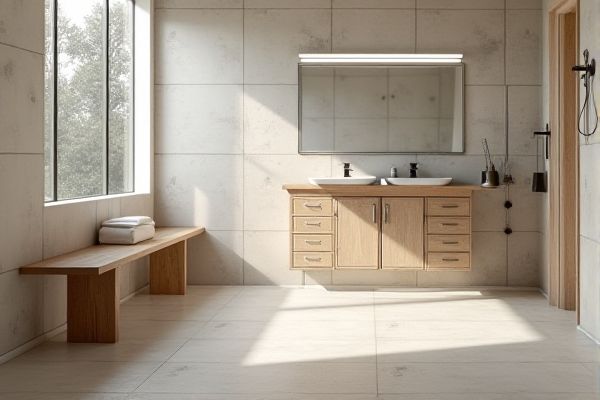
Wall tiles are typically thinner, lighter, and designed for vertical surfaces where heavy foot traffic isn't a concern, while floor tiles are thicker, more durable, and engineered to withstand constant wear and pressure. Understanding these differences helps You select the right tile for your project's longevity and aesthetic appeal; explore the full article to make an informed choice.
Table of Comparison
| Feature | Wall Tile | Floor Tile |
|---|---|---|
| Material | Lightweight ceramic, porcelain, glass | Durable ceramic, porcelain, natural stone |
| Thickness | Typically 6-8 mm | Typically 8-12 mm |
| Durability | Designed for low impact and less foot traffic | High resistance to wear, foot traffic, and impact |
| Slip Resistance | Low (not required) | High (required for safety) |
| Load Bearing | Not load bearing | Load bearing, withstands heavy weight |
| Installation Area | Vertical surfaces: walls, backsplashes | Horizontal surfaces: floors, patios |
| Cost | Generally lower cost | Generally higher cost due to durability |
| Design Options | More variety in colors and patterns | Varies; often textured or matte finishes |
| Water Resistance | High, suitable for wet areas | High, with added slip resistance |
Introduction to Wall Tiles and Floor Tiles
Wall tiles and floor tiles differ primarily in durability, thickness, and slip resistance to accommodate their specific uses. Wall tiles tend to be thinner, lighter, and more decorative, suitable for vertical surfaces in bathrooms and kitchens, while floor tiles are thicker and more robust, designed to withstand foot traffic and heavy wear. Understanding these functional differences helps you choose the right tile for your project, ensuring both aesthetic appeal and long-lasting performance.
Key Differences Between Wall Tiles and Floor Tiles
Wall tiles are typically thinner, lighter, and designed with a glazed finish for aesthetics and easy cleaning, whereas floor tiles are thicker, more durable, and engineered to withstand heavy foot traffic and impact. Floor tiles often have textured surfaces or anti-slip features to prevent slipping, while wall tiles prioritize smoothness and visual appeal. Material composition also varies, with floor tiles commonly made from porcelain or ceramic with higher PEI ratings, reflecting their enhanced resistance to wear and abrasion compared to wall tiles.
Material Composition: Wall Tile vs Floor Tile
Wall tiles are typically made from thinner, lighter materials like ceramic or porcelain with a smooth finish, designed for aesthetics rather than heavy wear. Floor tiles require denser, more durable materials such as porcelain or natural stone, engineered to withstand foot traffic, impact, and abrasion. Your choice should consider the material composition to ensure proper functionality and longevity in either vertical or horizontal applications.
Durability and Strength Comparison
Floor tiles are engineered to withstand heavy foot traffic and impacts, offering superior durability and strength compared to wall tiles that prioritize aesthetics and lightweight installation. Typically, floor tiles are thicker, denser, and made from materials such as porcelain or natural stone, designed to resist wear, scratches, and breakage. Wall tiles, often thinner and more delicate, lack the structural robustness required for flooring applications.
Slip Resistance and Safety Considerations
Wall tiles are generally smoother and less slip-resistant since they are not designed to withstand foot traffic, making them unsuitable for flooring areas where safety is critical. Floor tiles feature textured surfaces and higher coefficient of friction values to reduce slip hazards, essential for wet or high-traffic environments. Selecting floor tiles with rated slip resistance (measured by R-values or COF ratings) ensures optimal safety, while wall tiles prioritize aesthetics over grip.
Design and Aesthetic Options
Wall tiles offer a broader range of design and aesthetic options with intricate patterns, textures, and vibrant colors ideal for creating focal points and decorative accents. Floor tiles prioritize durability and slip resistance but come in various material types like porcelain, ceramic, and natural stone, allowing diverse finishes such as matte, polished, or textured. Both tile types cater to modern and classic styles, enabling customization in size, shape, and layout to enhance interior design effectively.
Installation Methods and Challenges
Wall tile installation typically involves adhesive mortar and thin-set, requiring precise alignment to ensure even spacing and a smooth finish, while floor tile installation demands a stronger substrate preparation with cement backer boards or concrete slabs to support heavier loads. Floor tiles often necessitate thicker adhesives and grout to withstand foot traffic and prevent cracking, whereas wall tiles are lighter and face fewer stress challenges during installation. Both require meticulous surface leveling, but floor tiles pose greater challenges in durability and load-bearing considerations during installation.
Cost Comparison: Wall Tiles vs Floor Tiles
Wall tiles generally cost less than floor tiles due to thinner material and lighter durability requirements, with prices ranging from $1 to $15 per square foot compared to floor tiles that range from $3 to $20 per square foot. Floor tiles require higher durability and slip resistance, which increases manufacturing and installation costs, impacting your overall budget. Choosing the right tile involves balancing aesthetics with functional cost, especially in high-traffic areas where floor tiles offer better long-term value despite initial expense.
Best Applications for Wall Tiles and Floor Tiles
Wall tiles are best suited for vertical surfaces in bathrooms, kitchens, and backsplashes where moisture resistance and ease of cleaning are essential. Floor tiles must offer higher durability and slip resistance, making them ideal for high-traffic areas like hallways, living rooms, and outdoor patios. Porcelain and ceramic are common materials chosen for both, with specific textures and thicknesses tailored to wall or floor use.
Maintenance and Longevity Factors
Wall tiles generally require less maintenance than floor tiles due to lower exposure to foot traffic and heavy wear. Floor tiles, especially those made from porcelain or ceramic, are designed to withstand impacts and frequent cleaning, enhancing their longevity when properly sealed and maintained. Choosing the right tile for your space ensures durability and reduces upkeep efforts, preserving the aesthetic appeal over time.
 homyna.com
homyna.com